The chipa. I’ve mentioned it before, it’s a cheese and cassava (tapioca) flour based bread. The word, in fact, is the Guarani word for bread, or cake. In its most historical form, it consisted of nothing more than pounded cassava (yuca/manioc) root and water, the dough wrapped around a stick and cooked over an open flame. That type of chipa is called the chipa chapuré, named after a jungle owl, though I’m not clear how they relate.
But given the generic meaning of the word, there are a large number of varieties of chipas out there. Over time, the traditional version has, more or less, disappeared, except in smaller communities in Paraguay and northern Argentina, primarily as a homemade bread. With the Spanish colonization, and the influences particularly from Jesuit missionaries, European techniques and ingredients (chickens and cows were brought from Europe) have influenced the modern day chipa, which now almost always includes both egg and dairy in its elaboration. They range in size from small, bite sized puffs, to larger buns, to rings, to… well, pretty much anything goes these days.
Some of the more well known versions include the chipa caburé I mentioned above, also known as the chipa mbocá; the modern version of it is generally just called a chipa, without an additional descriptor; the chipa so’ó, which is filled with ground meat; the chipa manduvi (aka chipa kandói) made from corn or cassava flour, and ground peanuts; chipa avati, made from cornflour and cassava flour, and chipa rora, which is made from what amounts to sort of corn bran – it’s the coarser part of the corn leftover from making cornflour, after it’s been sieved, a way of using up what otherwise might be discarded; the chipa argolla, which is shaped into a ring, and usually made with the same recipe as the avati, a mix of flours, and anise; and, the chipa pirú, which are little rings that have been cooked until crunchy. There are also related breads like the sopa paraguaya, literally Paraguayan soup, which is more or less like what we think of as a cheesy cornbread; and the chipa guazú, a sort of firm set corn and cheese custard.
I first learned to make them, wow, thirteen years ago. The version I learned then was made with cassava flour, egg, cheese, butter, and salt. It’s still probably the version I make most often, but over time, I’ve experimented with different versions. We had a request this week for a chipa that would remind our customer’s wife of the ones her mother used to make in Paraguay. Now, that was all the info I had to go on, which is often the way these special requests arrive. I decided to go with a version that I don’t often make, but that is very Paraguayan in style, the chipa avati.
This version is slightly more elaborate, though not by a lot. It’s a mix of two flours (250gm each), what’s called harina paraguaya, or Paraguayan flour, which is a very finely ground cornflour, it’s almost like cornstarch in texture, but made from the whole corn kernel, and fécula de mandioca, or cassava flour (aka, manioc flour, or tapioca starch). There are also 115gm softened butter (1/4 cup), 3 eggs, 125gm each of grated parmesan and mozzarella, a half teaspoon of salt, a teaspoon of baking powder (optional), and 120ml (1/2 cup) of milk. Optionally, particularly for festivals, a teaspoon of crushed anise seeds is added, though I didn’t for these.
Beat the eggs and the softened butter together.
Add the cheese (and anise if using), and mix together.
Add the milk, salt, and baking powder, mix.
Add the two starches and mix. It will form a firm mass, the texture of soft clay. Chill for about 20 minutes.
Form into balls and then flatten those into thick disks. Size is really up to you. Our customer wanted 20, I made 22 just to have a couple of extra “in case”, and cook’s nibble.
And, bake in a hot oven (220C/420F) for about 20 minutes, until golden brown and puffed up. With the cornflour, these don’t puff as much as the pure cassava flour ones, because it’s denser (and that’s part of the reason for adding the baking powder, I’ve been told, and it makes sense). Serve warm!
Expect more upcoming chipa posts as I explore my way through the various versions above! Probably excluding the one where I have to pound out fresh yuca root and make a mash that’s molded around a stick and charred over an open fire…. But hey, you never know.
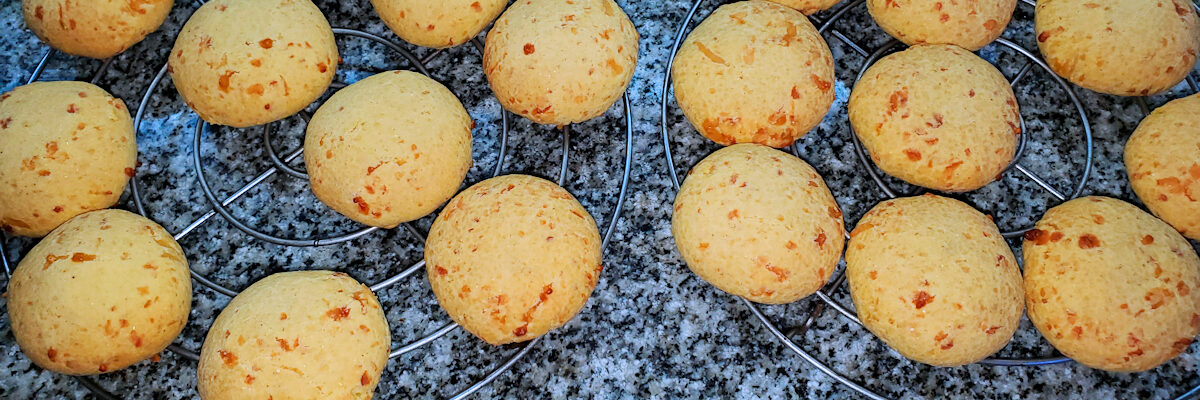
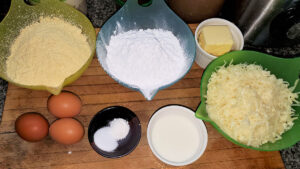
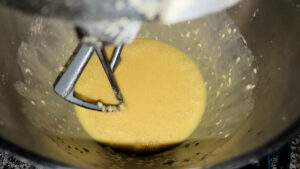
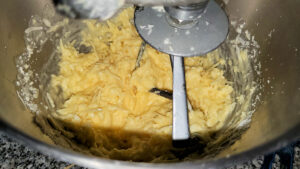
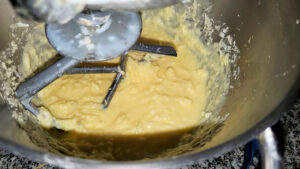
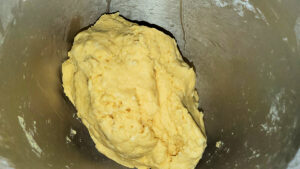
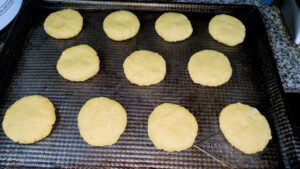
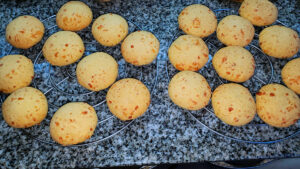
[…] I promised a couple of weeks ago, I’ll gradually start posting some of the other Chipa version recipes. This one is the […]
[…] because there’s no actual flour of any sort in it. On the other hand, as I talked about in my first post on chipas, the original “bread” was a mix of water and mashed yuca root, cooked over an open […]